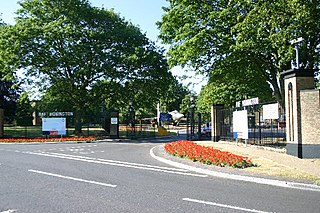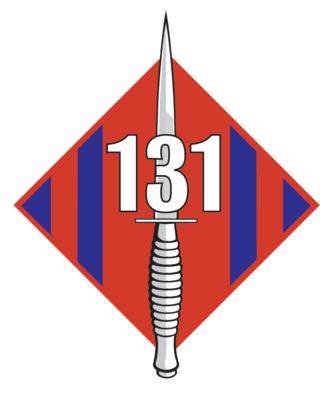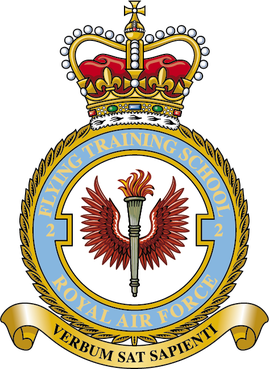
Royal Air Force Kenley, more commonly known as RAF Kenley is a former airfield station of the Royal Flying Corps in the First World War and the RAF in the Second World War. It played a significant role during the Battle of Britain as one of the three RAF stations specifically tasked with the defence of London. It is located near Kenley on the edge of Greater London. The site remains in use with the Ministry of Defence, as Kenley Airfield.
This is the Operation Telic order of battle, which lists the British forces that took part in Operation Telic, including

Royal Air Force Honington or more simply RAF Honington is a Royal Air Force station located 6 mi (9.7 km) south of Thetford near Ixworth in Suffolk, England. It was used as a bomber station during the Second World War and through the Cold War, hosting Handley Page Victors and Hawker Siddeley (Blackburn) Buccaneers. RAF Honington has been the RAF Regiment depot since 1994.

Royal Air Force Chivenor, or more simply RAF Chivenor, was a Royal Air Force station located on the northern shore of the River Taw estuary, on the north coast of Devon, England. The nearest towns are Barnstaple and Braunton.

Royal Air Force Topcliffe or RAF Topcliffe is a Royal Air Force station in North Yorkshire, England.

The Royal Citadel in Plymouth, Devon, England, was built in the late 1660s to the design of Sir Bernard de Gomme. It is at the eastern end of Plymouth Hoe overlooking Plymouth Sound, and encompasses the site of the earlier fort that had been built in the time of Sir Francis Drake. The citadel site is a Scheduled Monument and many of the buildings within are Grade II Listed.
The role of the Commando Logistic Regiment (CLR), Royal Marines is to provide second line Combat Service Support to 3 Commando Brigade.

A Volunteer Gliding Squadron (VGS) is an aircraft squadron of the Royal Air Force (RAF) which provides flying training in glider aircraft for Royal Air Force Air Cadets. All current operational Volunteer Gliding Squadrons operate a sole type of aircraft, the Grob G103A Twin II Acro, a conventional winch-launched tandem-seat sailplane known by its British military designation, Viking T1.
24 Commando Royal Engineers is a unit of the British Army's Royal Engineers supporting 3 Commando Brigade.

Royal Air Force Keevil or more simply RAF Keevil is a former Royal Air Force station lying between the villages of Keevil and Steeple Ashton, about 4 miles (6.4 km) east of the town of Trowbridge, in Wiltshire, England.

Royal Air Force Hullavington, or more simply RAF Hullavington, was a Royal Air Force station located at Hullavington, near Chippenham, Wiltshire, England. The station opened in June 1937 and was primarily used for training. It closed on 31 March 1992 when it was transferred to the British Army and renamed Buckley Barracks. The airfield part of the site, known as Hullavington Airfield, continued to be used for RAF gliding operations until 2016 when it was sold to technology company Dyson.
This is the Operation Herrick ground order of battle, which lists any British ground forces that have taken part in the duration of Operation Herrick between 2002 and 2014.
Royal Air Force Kirton in Lindsey or more simply RAF Kirton in Lindsey is a former Royal Air Force station located 15 miles (24 km) north of Lincoln, Lincolnshire, England.

131 Commando Squadron Royal Engineers is an Army Reserve unit and part of 24 Commando Regiment Royal Engineers. It provides engineering support to 3 Commando Brigade Royal Marines and is the largest Army Reserve Commando unit. The squadron has deployed worldwide to provide combat engineer support to 3 Cdo Bde RM, often deploying in small sub-units. 131 was first raised in 1947 as an airborne engineer regiment, and reached a strength of over 1,000 trained parachute engineers by the early 1960s. Between 1 April 1978 and 1 October 2015, the unit was an independent Commando squadron under operational command of HQ 3 Cdo Bde RM. On 2 October 2015, it formally became the third squadron of 24 Commando Engineer Regiment.

Wattisham Airfield is a British Army airfield and barracks located near the village of Wattisham in Suffolk, England. It is home to the Army Air Corps' Apache attack helicopter force. A helicopter repair facility provided by 7 Aviation Support Battalion, REME and 132 Aviation Supply Squadron, RLC is also based at the airfield.

RM Condor is a large Royal Marines base located near Arbroath in East Angus, Scotland. The base also houses 7 (Sphinx) Battery Royal Artillery, part of 29 Commando Regiment Royal Artillery.

No.2 Flying Training School is a Flying Training School (FTS) of the Royal Air Force (RAF). It is part of No. 22 (Training) Group that delivers glider flying training to the Royal Air Force Air Cadets. Its headquarters is located at RAF Syerston in Nottinghamshire and gliding takes places from several sites throughout the UK using the Grob Viking T1. The RAF Central Gliding School is also under its command.

The page contains the current structure of the British Army. The British Army is currently being reorganised to the Future Soldier structure.
At the end of the Cold War in 1989, the Royal Air Force (RAF) structure was as follows:
This is the structure of the Royal Air Force, as of October 2020.



















